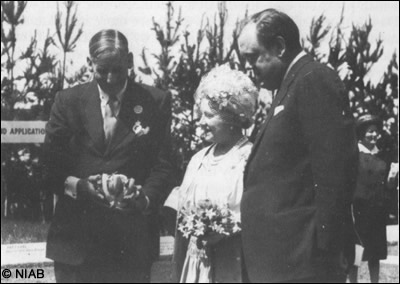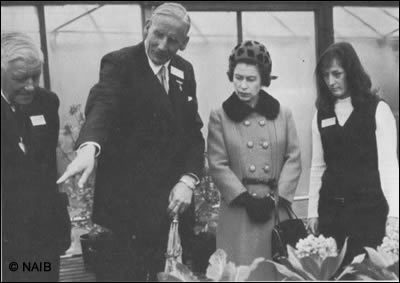Napoleon famously said that, “an army marches on its stomach”, and during the Second World War the home front played an important role in keeping the British population and the soldiers fed despite a German naval blockade. Sailors risked their lives to bring in supplies through U-boat patrolled waters, but farmers, scientists and amateur gardeners all played their part in increasing food production. This article is about the small part played by one of my mother’s cousins, Frank Horne, in the struggle to keep the nation fed.
I suppose this story starts with my ancestors the Hornes who were market gardeners in the fertile vale of Evesham in Worcestershire – an area still famous today for growing fruit and vegetables. One of the family however, Joseph Horne, moved to Moreton in Marsh, a small market town in the Cotswolds, and by 1860 Thomas Horne, my 2x great grandfather, was trading as a corn dealer and seed merchant there and also farming a Cotswold hill farm. He must have found the poor soil and wind swept hills very different from the Worcestershire lowlands. None the less, his business prospered and local farmers valued his practical advice on what seed to sow for maximum yield.

Frank showing winter cauliflower to H.M. Queen Elizabeth the Queen Mother, at the Royal Show, Cambridge, July 1961.
Reproduced with the kind permission of the NIAB
His son Francis Horne, my great grandfather, added coal delivery and a grocers shop. His wife Emma Baines, who came from a non-conformist family in Leicestershire, had been orphaned by the time she was twelve – two of her siblings had died of scarlet fever and her mother and father and remaining brother and sister of tuberculosis (TB). Like many girls in her situation she trained as a governess and met Francis when she found a job in Moreton in Marsh.
Emma and Francis had seven children. Their eldest son, Tom, was a bit of a rebel and ran away to London where he found a job with Harrods, who sent him to Edinburgh as a carpet buyer. While skating on a loch he met Jessie Baxter who worked in a furriers shop in Princes Street [Edinburgh] and in 1903 they were married.
The couple returned to London and in 1904 a son, Frank, was born, and in 1907 a daughter Agnes. Thomas, however, had developed a troubling cough and it was felt that he needed country air. His brother Ernest, my grandfather, was running a grocery business in Hertfordshire and invited Tom to join him. Frank enjoyed riding around in a horse and cart delivering groceries. In 1909 Thomas Horne senior died and another brother, Harry, invited Tom back to Moreton to help with the seed and corn business which was flourishing. Frank was enroled in a small private school which had been started by his grandmother to educate her own and her neighbours’ children. Frank also helped on the family farm. Tom’s health was worsening. Before antibiotics, TB was a death sentence, and it was decided that he needed sea air. Tom and Jessie moved to Exmouth and set up a seed business and as soon as he was old enough, at 14, Frank left school to help his mother run it.
His uncle Frederic Horne, who had spent time farming in Australia, was living in Exmouth and let Frank use his garden to keep poultry and grow vegetables to help feed his family. Tom died in 1918, leaving Jessie a widow at 33 with two young children, but luckily she was able to appoint an able manager for the shop, relieving Frank of some of his duties.
However his family were concerned about Frank who had had little education and seemed to have poor prospects. They must have wondered what to do about a boy whose main interest seemed to be gardening. Help was at hand. In 1920 when Seale Hayne Agricultural College (now part of the University of Plymouth) opened in Newton Abbott, 15 year old Frank was on the steps having secured one of the first scholarships. Most of the other students were considerably older with many being soldiers who had returned from the First World War determined to turn their swords into ploughshears. Frank loved the work. He spent a term in Kilmarnock to take the National Diploma in Dairying, and in 1922 he went to Leeds in Yorkshire to take the National Diploma in Agriculture. He was helped by his large build (he eventually grew to 6ft 6in tall). My mother could remember his first car was an Austin Seven with a sunshine roof and that he would remove the front seat to exit via the roof.
Despite having left school at 14 he did well in his exams and his tutors encouraged him to apply to university, and in 1923 he obtained a scholarship to study natural sciences at Christ College, Cambridge. He managed to pass his exams despite spending several weeks as a volunteer police constable in London during the General Strike of 1926. Later that year he obtained a post as a biology master at Greesham school in Holt in Norfolk, and in 1927 he met and fell in love with Marjorie Bannister. Her father agreed to the match providing Marjorie always had help in the house. They had to return home from their honeymoon two days early because the broccoli was due to pollinate. This was to set the tone for their married life.

In 1928 he was offered the post of head of biology at Seale Hayne College in Devon. The college worked closely with local farmers to improve the quality of seed. Frank’s life long interest was in winter broccoli and cauliflower which would give farmers a second harvest and another source of income. The problem was that the English varieties tended to have yellow heads and be easily damaged by frost. At that time much winter cauliflower was imported from Brittany, and Frank and his assistant made trips to France to gather seed and began cross pollination experiments. Before the advent of F1 hybrid crops, seeds did not breed true and after Frank was joined in his research by his cousin, Ken Haine, the seeds were known by farmers as Haine’s 57. The pair also worked on anemone research, which was also grown as a mid season cash crop by local farmers. They were trying to solve the problem of the seed whereby brightly coloured plants produced pastel flowers.
When the Second World War broke out in 1939, staff at the agricultural college were seconded to the government food production effort. In January 1940 Frank Horne, then aged 35, was given a position as officer for derelict land and drainage in Devon. He was charged with reclaiming land that had never been cultivated or had gone out of cultivation.
His labour force was composed of members of the women’s land army, prisoners of war, conscientious objectors and even school children. Frank proposed reseeding gorse moors with grass, then an innovation, and introduced new crops such as oil seed rape. He was also able to use a series of demonstration plots to show farmers a range of cereal varieties and grass mixtures. His work attracted the attention of his old tutors at Cambridge and in 1944, he was invited to apply for the post of deputy director of the National Institute of Agricultural Botany (NIAB) at Cambridge and the Cambridge Plant Breeding Institute.
Several other universities, including the London School of Economics, had already been evacuated to Cambridge and the only house the Hornes could find for a family, which by now included four young children, had no bathroom or electricity. The government had asked the NIAB to organise a countrywide supply of seeds for cereals and other crops. Before the war there was no check on seeds being sold under several different names and his first task was to develop a generic list of seed varieties. Regional trial centres were established to represent the varying types of soil and climate, including one in Edinburgh.
In 1945 Frank became director of the NIAB and the Cambridge Plant Breeding Institute, a post he was to hold for the next 25 years. In 1958 he received a CBE in the New Year’s Honours List. He died of a heart attack in 1975.
anniern
© anniern 2010
SOURCES
Much of the information in this article is taken from “From Seedtime to Harvest” by Rosemary Sellis (Frank’s daughter). Hobson Press Cambridge
NIAB TAG (National Institute of Agricultural Botany)